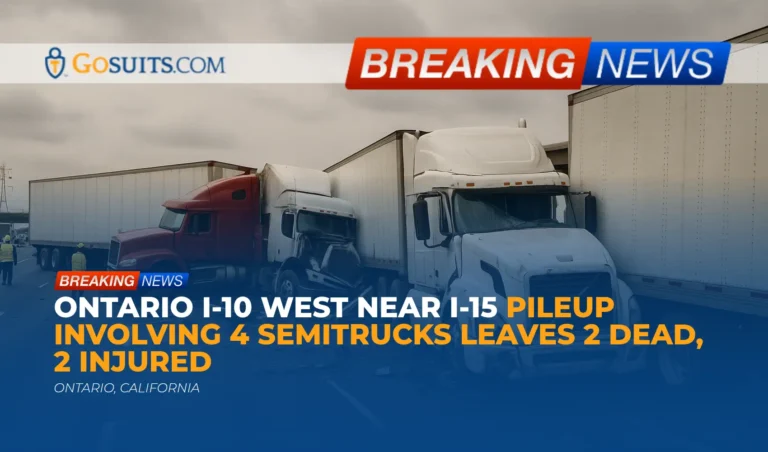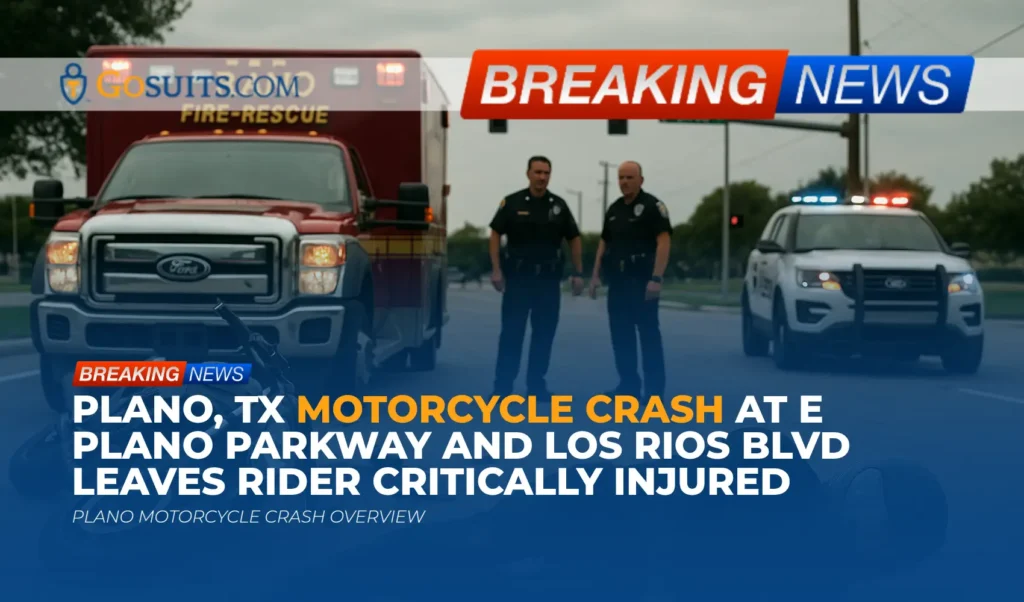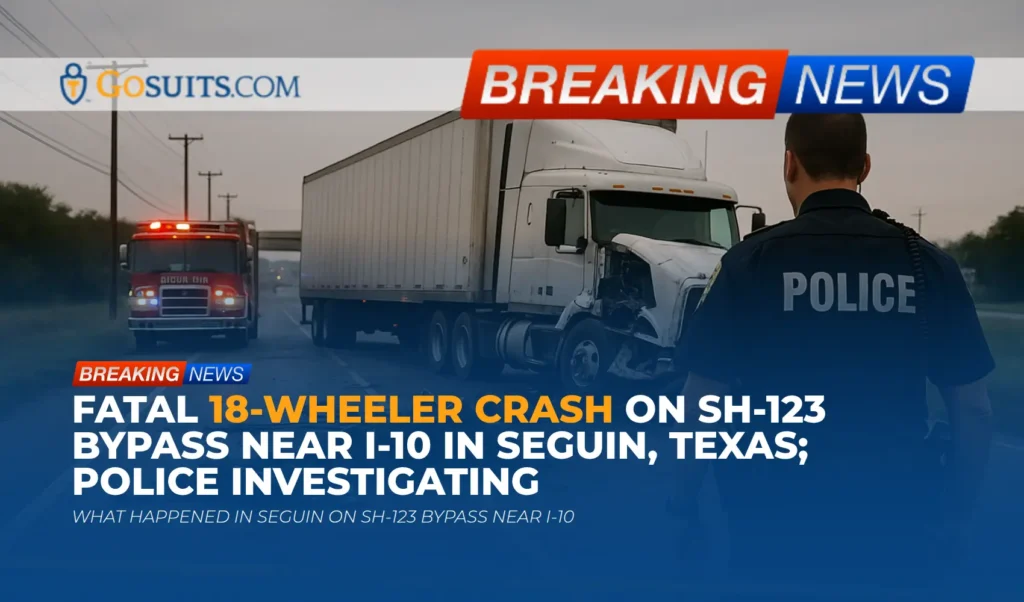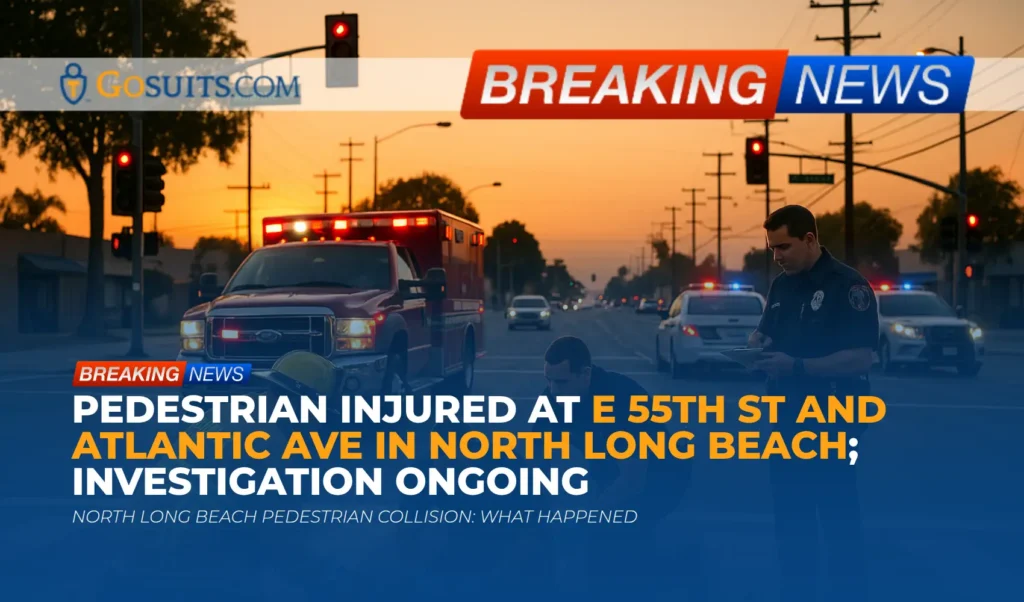- Overview of the crash on westbound I-10 near I-15 in Ontario
- What we know and what remains under investigation
- Why pileups with semitrucks cause catastrophic harm
- Immediate steps to preserve safety and information
- How to obtain official records and updates
- California Highway Patrol collision report
- San Bernardino County Sheriff-Coroner and autopsy information
- Death certificates and vital records
- Road closure and traffic updates from Caltrans
- Potential civil liability in a multivehicle truck crash
- Key evidence to secure in truck-involved collisions
- Insurance and coverage considerations with commercial carriers
- Timelines and filing windows in California civil cases
- Community safety takeaways for similar corridors
- How a claim typically progresses after a freeway pileup
- Commentary from Gosuits Ontario, California Personal Injury Attorney
- Time-sensitive action checklist
Overview of the crash on westbound I-10 near I-15 in Ontario
Authorities reported a violent multivehicle crash on the westbound 10 Freeway just east of the 15 Freeway in Ontario on Tuesday, October 21, 2025, shortly before 1:15 p.m. The collision involved as many as eight vehicles, including four semitrucks, and resulted in the tragic loss of two lives. Two additional people were transported to area hospitals with major injuries. California Highway Patrol indicated that several lanes were closed, causing substantial traffic impacts in the area. The cause of the crash was not immediately known at the time of reporting.
This corridor is one of the busiest freight and commuter routes in Southern California, where passenger vehicles and heavy commercial trucks share limited roadway space at high speeds. When a pileup occurs in such conditions, the consequences can be severe, and the investigative and recovery process can be complex and lengthy.
What we know and what remains under investigation
Based on initial information released by law enforcement, the collision involved multiple vehicles and at least four semitrucks. Two people were pronounced deceased, and two others sustained major injuries and were taken to nearby hospitals. The crash occurred on the westbound 10 Freeway near the I-15 interchange. Several lanes were closed for investigation and clean-up, which is typical for major collisions that require thorough scene documentation and heavy-duty towing.
Key facts that are typically established in the early phase include:
- Number and types of vehicles involved, including commercial vehicles and passenger cars.
- Location and time of the incident, which can affect lighting, traffic density, and speed conditions.
- Initial injury and fatality updates, often preliminary until next-of-kin are notified and hospital assessments are completed.
- Lane closures and traffic control, which may continue while investigators conduct measurements, inspections, and debris removal.
What remains under investigation typically includes vehicle speeds, following distances, sequence of impacts, any mechanical issues, driver behavior, and whether all drivers complied with traffic and federal motor carrier safety rules. In multivehicle truck collisions, investigators often review electronic data from commercial vehicles, driver logs, and maintenance records.
Why pileups with semitrucks cause catastrophic harm
Crashes that involve large trucks often lead to severe outcomes because of the differences in size, weight, and stopping distances between trucks and passenger vehicles. Large combination trucks can weigh up to 80,000 pounds under federal limits, making impact forces much greater. Stopping distances are longer, and visibility challenges, blind spots, and load stability can complicate emergency maneuvers.
National safety agencies provide context for these risks. The National Highway Traffic Safety Administration describes the higher fatality risk in collisions involving large trucks and offers safety guidance for sharing the road with them. See NHTSA’s resource page on large trucks at nhtsa.gov/road-safety/large-trucks. The Federal Motor Carrier Safety Administration has published research on crash factors and the role of driver, vehicle, and environment in large truck crashes, which can help inform both prevention and post-crash analysis. See FMCSA’s materials, including its crash causation study overview, at fmcsa.dot.gov/safety/research-and-analysis/large-truck-crash-causation-study.
When multiple vehicles are involved, the chain-reaction nature of impacts can produce secondary crashes that are different from the initial collision mechanism. Secondary collisions may happen as drivers brake abruptly, change lanes to avoid debris, or encounter reduced visibility due to dust, smoke, or weather. These dynamics complicate fault allocation and evidence analysis.
Immediate steps to preserve safety and information
In the aftermath of a crash like this, safety and medical care are the top priorities. Once immediate dangers are addressed, preserving information can be critical for understanding what happened and for future insurance or civil claims. Every situation is different, but generally, the following steps can help protect well-being and information:
- Seek medical evaluation promptly even if injuries seem minor. Some injuries become apparent hours or days later.
- Preserve photographs and videos of vehicle positions, roadway markings, debris, skid marks, license plates, and any identifiable company markings on trucks.
- Collect witness names and contact information if it can be done safely. Independent witness accounts can be important when recollections differ.
- Keep medical and expense records including bills, discharge summaries, prescriptions, and time away from work.
- Avoid detailed statements to insurance adjusters until consulting with a qualified attorney. What is said early can be used later and may be misinterpreted.
- Do not authorize vehicle disposal or repairs until advised. The vehicle may contain crucial data and physical evidence.
Commercial truck carriers must follow specific federal safety rules, including post-accident procedures such as mandatory testing under certain circumstances. FMCSA requires post-accident alcohol and controlled substances testing for commercial drivers in defined scenarios. See 49 CFR 382.303 at fmcsa.dot.gov/regulations/drug-alcohol-testing/section-382303-post-accident-testing. Understanding whether such testing occurred is part of a thorough review following a serious crash.
How to obtain official records and updates
Official records help clarify the facts and are often needed for insurance and civil matters. Multiple agencies may hold different parts of the record. The locations and processes below are typical for incidents in this area of San Bernardino County. Response times can vary based on investigation complexity.
California Highway Patrol collision report
For crashes on freeways in this area, the California Highway Patrol generally prepares the traffic collision report. Collision reports can be requested from the CHP Area office that handled the investigation. CHP explains eligibility and the request process here: chp.ca.gov/notify-chp/collision-report. If the specific Area office is not known, CHP’s office locator may help: chp.ca.gov/find-an-office.
When requesting, it is helpful to have the date, time, location, and, if available, the CHP incident number. Reports may not be immediately available if the investigation is ongoing or if the case involves a fatality requiring further review.
San Bernardino County Sheriff-Coroner and autopsy information
In fatal incidents in San Bernardino County, the Sheriff-Coroner’s office typically conducts death investigations and, when appropriate, autopsies. The Sheriff-Coroner provides guidance on how next of kin can obtain autopsy and coroner reports, as well as timelines for release. Visit the San Bernardino County Sheriff’s site for Coroner Division information: sbcsherriff.org.
Families are often asked to provide identification and proof of next-of-kin status when requesting records. Coroner reports can take time, especially in complex incidents. If toxicology testing is required, results may add weeks to the timeline.
Death certificates and vital records
Certified copies of death certificates in San Bernardino County are handled by the County’s Department of Public Health Vital Records Office. Instructions for eligibility, ordering, and processing times are available here: dph.sbcounty.gov/programs/vital-records/. Death certificates are often needed for estate matters, benefits, and any wrongful death claims.
Road closure and traffic updates from Caltrans
Caltrans provides real-time traffic updates, lane closures, and incident information that can help clarify roadway conditions and reopening times. The statewide QuickMap is available at quickmap.dot.ca.gov. Note that Caltrans incident logs are primarily operational, but snapshots of conditions can help form a timeline.

Potential civil liability in a multivehicle truck crash
Liability in an eight-vehicle collision that includes multiple semitrucks is rarely simple. California uses a comparative fault framework, which means responsibility can be apportioned among multiple drivers and entities. In truck-involved cases, potential parties can include a commercial driver, a motor carrier, a broker or shipper depending on facts, a maintenance contractor, or a vehicle or component manufacturer if a defect contributed.
Important considerations commonly assessed:
- Driver conduct such as speed, following distance, lane changes, and attentiveness.
- Hours-of-service compliance to evaluate fatigue. FMCSA’s summary of hours-of-service rules is here: fmcsa.dot.gov/regulations/hours-service/summary-hours-service-regulations.
- Vehicle condition and maintenance including brakes, tires, and load securement. Federal rules require carriers to systematically inspect and maintain vehicles, see 49 CFR part 396 summarized by FMCSA at fmcsa.dot.gov/regulations/title49/part/396.
- Post-crash testing and documentation as required in certain crashes, see 49 CFR 382.303 at fmcsa.dot.gov/regulations/drug-alcohol-testing/section-382303-post-accident-testing.
- Operational oversight by the carrier including training, supervision, and incident history. Carriers must keep an accident register and supporting documents as outlined at 49 CFR 390.15, see fmcsa.dot.gov/regulations/title49/section/390.15.
If an unsafe condition on the roadway contributed, potential claims involving a public entity require special notice within specific timeframes. In California, many claims against public entities have a six-month presentation deadline. See Government Code section 911.2 at leginfo.legislature.ca.gov. This is a limited overview that is offered for general information. Every case turns on its particular facts.
Key evidence to secure in truck-involved collisions
Evidence can fade quickly after a major freeway crash. Vehicles are towed, electronic data can be overwritten, and memories change. Preserving evidence early helps ensure that the true sequence of events can be reconstructed. Examples of evidence that often matter:
- Electronic logging device records and driver hours-of-service data. Carriers must retain certain hours-of-service records for defined periods. See FMCSA’s hours-of-service overview at fmcsa.dot.gov/regulations/hours-service/summary-hours-service-regulations.
- Event data recorder and engine control module data from trucks and passenger vehicles, which can show speed, braking, and throttle before impact.
- Dash camera and in-cab video, sometimes managed by third-party telematics vendors integrated with the carrier.
- Bills of lading and dispatch records that establish pickup and delivery windows, load type, and scheduling pressures.
- Vehicle inspection and maintenance records required under federal regulations, see 49 CFR part 396 at fmcsa.dot.gov/regulations/title49/part/396.
- Post-crash inspection findings that may reveal brake imbalance, tire failures, lighting issues, or load securement problems.
- 911 call logs, CAD logs, and scene diagrams often maintained by responding agencies.
- Photos, drone images, and total station measurements used by investigators to map vehicle positions and evidence.
Sending prompt, properly directed preservation requests can help prevent deletion or alteration of time-sensitive records. Because communications with insurers and carriers can affect later proceedings, it is generally wise to consult with a seasoned attorney before initiating those contacts.
Insurance and coverage considerations with commercial carriers
Commercial trucks involved in interstate commerce are required to carry substantial liability insurance. FMCSA outlines minimum financial responsibility levels for for-hire carriers, which typically range from 750,000 dollars to 5,000,000 dollars depending on cargo. See FMCSA’s summary at fmcsa.dot.gov/registration/insurance-requirements. In multivehicle crashes, several policies may be implicated, including primary liability, excess or umbrella policies, trailer interchange, and potentially shipper or broker policies depending on control and contractual relationships.
California is a comparative fault state, so recovery can be affected by how fault is apportioned among drivers and entities. That allocation can evolve as more evidence becomes available. Early statements to insurance adjusters can be taken out of context. Consulting an attorney first is advisable so that communications are accurate, complete, and strategic.
When the at-fault driver is a commercial operator, the carrier and its insurer often mobilize rapid-response teams, including investigators and adjusters. Claimants who are not familiar with trucking insurance may face pressure to provide recorded statements, sign medical authorizations that are too broad, or accept early settlement offers before injuries are fully understood. Taking time to understand rights and options can help avoid unintended consequences.
Timelines and filing windows in California civil cases
California law sets strict deadlines for filing civil claims. For most personal injury and wrongful death claims arising from motor vehicle crashes, the general statute of limitations is two years from the date of injury or death. See Code of Civil Procedure section 335.1 at leginfo.legislature.ca.gov. There are exceptions that can shorten or lengthen these deadlines based on specific circumstances.
If a potential claim involves a public entity, such as a dangerous condition of public property, California Government Code typically requires a written claim to be presented within six months. See Government Code section 911.2 at leginfo.legislature.ca.gov. These timeframes are unforgiving. It is important to track dates and to understand which deadlines apply.
Community safety takeaways for similar corridors
The I-10 and I-15 interchange area experiences heavy traffic volumes, frequent lane changes, and significant truck traffic. While the cause of this particular crash has not been released, general safety practices can reduce risks for everyone:
- Maintain longer following distances around trucks because their stopping distances are greater and their sight lines differ from passenger cars.
- Avoid lingering in truck blind spots, especially along the right side and directly behind the trailer.
- Plan lane changes early near major interchanges and avoid abrupt maneuvers when traffic is dense.
- Adjust speed to conditions, especially during congestion, construction zones, or poor visibility.
- Secure loads and check vehicle condition to reduce debris and mechanical failures that can trigger chain-reaction events.
Public agencies and freight operators continue to study ways to reduce truck-involved crashes through engineering, enforcement, and education. NHTSA’s large truck safety page provides additional perspective at nhtsa.gov/road-safety/large-trucks.
How a claim typically progresses after a freeway pileup
Every collision is unique, but the path of a civil insurance claim often follows recognizable stages. Understanding the typical flow can help set expectations. This is general information only and not tailored to any specific situation.
- Initial investigation. Collect medical records, photographs, witness information, and, when available, the police report. If a commercial vehicle is involved, identify the carrier and request preservation of logs and electronic data.
- Liability analysis. Review scene evidence, vehicle data, and applicable traffic and federal motor carrier regulations. In complex cases, collision reconstruction or truck operations consultants may be used to clarify the sequence and contributing factors.
- Insurance notice. Notify potentially responsible insurers. Because statements can affect outcomes, consider consulting an attorney before any recorded interviews.
- Damages documentation. Compile medical treatment, projected care needs, wage loss, out-of-pocket costs, and property damage. Consider the long-term impact of injuries rather than only immediate expenses.
- Negotiation. Exchange information with insurers. Early offers may not account for ongoing medical needs or later-identified injuries.
- Litigation if needed. If settlement is not feasible, a lawsuit may be filed. This triggers formal discovery that can secure documents and sworn testimony that are not always accessible pre-suit.
- Resolution. Cases can resolve through settlement, mediation, or trial. Timeframes vary widely, especially in multivehicle matters with multiple insurers and complex fault apportionment.
At each step, accuracy and completeness of information matter. Early missteps, especially with insurer communications, can have lasting effects. It is generally prudent to speak with an attorney before engaging with insurers so that rights are protected and the strategy fits the specific facts.
Commentary from Gosuits Ontario, California Personal Injury Attorney
Our hearts go out to everyone affected by the collision on the westbound 10 Freeway near the I-15 interchange. Losing loved ones or coping with life-altering injuries is an immense hardship. This article is intended to provide educational and general information to help the community understand what typically happens after a serious truck-involved crash and where important records can be found.
From a civil injury perspective, a multivehicle crash involving several semitrucks requires careful attention to evidence that is unique to commercial operations. Hours-of-service compliance, vehicle maintenance, load securement, and in-cab video are all pieces of the puzzle. Because fault can be shared among multiple drivers and entities, early preservation of electronic data and prompt requests to the appropriate carrier or carriers can make a meaningful difference in understanding what happened.
In our experience, insurance companies and large corporate defendants often move quickly after a serious crash. Adjusters and defense teams may reach out early, request broad medical authorizations, or encourage recorded statements. People who are injured or grieving are at a disadvantage in those moments. The information shared can be used later and sometimes taken out of context. Taking time to learn about rights, obligations, and the scope of coverage before engaging with insurers can help balance the process.
A free consultation with a seasoned injury attorney can be an important first step to understanding options. It allows time to discuss the facts, the applicable rules, the documents that need to be preserved, and the timelines that may apply, without pressure to make immediate decisions.

Time-sensitive action checklist
The following steps outline practical actions that are often time-sensitive after a serious multivehicle collision. These items are intended to promote safety, preserve information, and help prevent avoidable setbacks later.
- Prioritize medical care and follow-up. Timely evaluation documents injuries and supports appropriate treatment planning.
- Secure vehicles and property. Ensure that damaged vehicles are not destroyed or repaired before an opportunity to inspect and download electronic data.
- Preserve electronic evidence. Request that involved carriers retain electronic logging device data, in-cab video, dispatch communications, and maintenance records that can be overwritten with time.
- Request official records when available. Obtain the CHP traffic collision report, coroner documentation where applicable, and death certificates as soon as they become available.
- Document all losses. Keep a running file of medical bills, mileage, lost work, property damage, and any out-of-pocket costs.
- Avoid early insurer interviews. Refrain from recorded statements or broad medical authorizations until there is clarity on rights and strategy. What is said early can be used later.
- Calendar legal deadlines. Track the two-year general statute of limitations and any shorter public entity claim deadlines that might apply.
- Seek a free legal consultation before contacting insurers. Understanding rights and obligations at the outset helps prevent missteps and protects important claims.
References
– NHTSA, Large Trucks: nhtsa.gov/road-safety/large-trucks
– FMCSA, Large Truck Crash Causation Study: fmcsa.dot.gov/safety/research-and-analysis/large-truck-crash-causation-study
– FMCSA, Hours-of-Service Summary: fmcsa.dot.gov/regulations/hours-service/summary-hours-service-regulations
– FMCSA, Post-Accident Testing, 49 CFR 382.303: fmcsa.dot.gov/regulations/drug-alcohol-testing/section-382303-post-accident-testing
– FMCSA, Accident Register, 49 CFR 390.15: fmcsa.dot.gov/regulations/title49/section/390.15
– FMCSA, Insurance Requirements for Motor Carriers: fmcsa.dot.gov/registration/insurance-requirements
– California Highway Patrol, Collision Reports: chp.ca.gov/notify-chp/collision-report
– California Highway Patrol, Find an Office: chp.ca.gov/find-an-office
– San Bernardino County Sheriff, Coroner Division information: sbcsherriff.org
– San Bernardino County Department of Public Health, Vital Records: dph.sbcounty.gov/programs/vital-records/
– Caltrans QuickMap: quickmap.dot.ca.gov
– California Government Code section 911.2: leginfo.legislature.ca.gov
– California Code of Civil Procedure section 335.1: leginfo.legislature.ca.gov






